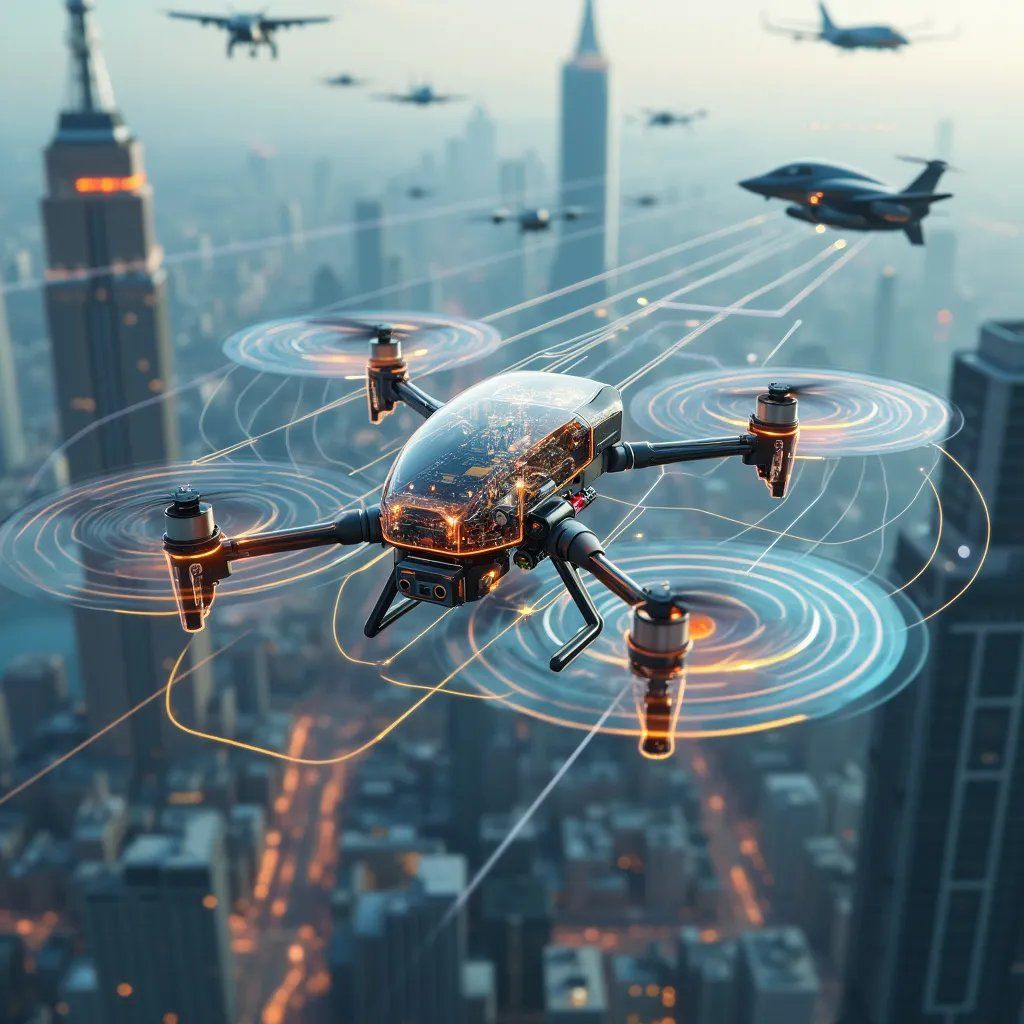Úvod
Technológia ADS-B (Automatic Dependent Surveillance-Broadcast) predstavuje zásadný pokrok v prevádzke bezpilotných lietadiel, pretože umožňuje sledovanie a identifikáciu bezpilotných lietadiel v reálnom čase v spoločnom vzdušnom priestore. Tento systém zvyšuje situačné povedomie a bezpečnosť prostredníctvom automatického hlásenia polohy a výmeny údajov.
Architektúra systému
Systém ADS-B implementuje sofistikované funkcie sledovania a vysielania prostredníctvom integrovaných komponentov, ktoré zabezpečujú hlásenie polohy, prenos a príjem údajov vo viacerých frekvenčných pásmach.
Implementácia systému ADS-B pre drony
importovať hashlib
čas dovozu
importovať náhodné
from enum import Enum
from dataclasses import dataclass
from typing import Dict, List, Optional, Tuple
import logging
# Konfigurácia protokolovania
logging.basicConfig(level=logging.INFO)
logger = logging.getLogger(__name__)
trieda DroneStatus(Enum):
FRIEND = "Priateľ"
FOE = "Nepriateľ"
UNKNOWN = "Neznámy"
trieda ResponseCode(Enum):
VALID = "Valid"
INVALID = "Invalid"
NO_RESPONSE = "Žiadna odpoveď"
@dataclass
trieda IFFResponse:
časová značka: float
response_code: ResponseCode
drone_id: str
podpis: str
pozícia: Tuple[float, float, float] # lat, lon, alt
trieda IFFTransponder:
def __init__(self, drone_id: str, secret_key: bytes):
self.drone_id = drone_id
self.secret_key = secret_key
self.position = (0.0, 0.0, 0.0)
self.last_challenge = None
def update_position(self, lat: float, lon: float, alt: float):
"""Aktualizovať pozíciu dronu"""
self.position = (lat, lon, alt)
def generate_response(self, challenge: bytes) -> IFFResponse:
"""Generovať odpoveď na výzvu IFF"""
vyskúšať:
# Vytvorenie podpisu pomocou výzvy a tajného kľúča
podpis = hmac.new(
self.secret_key,
challenge + self.drone_id.encode(),
hashlib.sha256
).hexdigest()
return IFFResponse(
timestamp=time.time(),
response_code=ResponseCode.VALID,
drone_id=self.drone_id,
podpis=podpis,
position=self.position
)
okrem výnimky ako e:
logger.error(f”Failed to generate response: {e}”)
return IFFResponse(
timestamp=time.time(),
response_code=ResponseCode.INVALID,
drone_id=self.drone_id,
podpis="",
position=self.position
)
trieda IFFInterrogator:
def __init__(self):
self.trusted_drones: Dict[str, bytes] = {}
self.challenge_history: List[bytes] = []
self.response_cache: Dict[str, List[IFFResponse]] = {}
def register_drone(self, drone_id: str, secret_key: bytes):
"""Zaregistrujte dôveryhodný dron"""
self.trusted_drones[drone_id] = secret_key
self.response_cache[drone_id] = []
def generate_challenge(self) -> bytes:
"""Generovanie náhodnej výzvy"""
challenge = secrets.token_bytes(32)
self.challenge_history.append(výzva)
výzva na vrátenie
def verify_response(self, response: IFFResponse) -> DroneStatus:
"""Overiť odpoveď IFF a klasifikovať dron"""
if response.response_code != ResponseCode.VALID:
vrátiť DroneStatus.UNKNOWN
if response.drone_id not in self.trusted_drones:
vrátiť DroneStatus.FOE
# Overenie podpisu
secret_key = self.trusted_drones[response.drone_id]
expected_signature = hmac.new(
secret_key,
self.challenge_history[-1] + response.drone_id.encode(),
hashlib.sha256
).hexdigest()
if response.signature != expected_signature:
vrátiť DroneStatus.FOE
# Platná odpoveď v medzipamäti
self.response_cache[response.drone_id].append(response)
if len(self.response_cache[response.drone_id]) > 100:
self.response_cache[response.drone_id].pop(0)
vrátiť DroneStatus.FRIEND
def get_nearby_drones(self, position: Tuple[float, float, float],
radius: float) -> Dict[str, DroneStatus]:
"""Získajte stav blízkych dronov"""
nearby_drones = {}
current_time = time.time()
for drone_id, responses in self.response_cache.items():
ak nie sú odpovede:
pokračovať
latest_response = responses[-1]
if current_time - latest_response.timestamp > 60: # 60-sekundový timeout
pokračovať
# Výpočet vzdialenosti (zjednodušene)
vzdialenosť = suma((a - b) ** 2 pre a, b v
zip(position, latest_response.position)) ** 0.5
if distance <= radius:
nearby_drones[drone_id] = self.verify_response(latest_response)
return nearby_drones
trieda DroneIFFSystem:
def __init__(self, drone_id: str):
self.drone_id = drone_id
self.secret_key = secrets.token_bytes(32)
self.transponder = IFFTransponder(drone_id, self.secret_key)
self.interrogator = IFFInterrogator()
def initialize(self):
"""Inicializácia systému IFF"""
# Zaregistrujte sa ako dôveryhodný dron
self.interrogator.register_drone(self.drone_id, self.secret_key)
logger.info(f "IFF systém inicializovaný pre dron {self.drone_id}")
def process_nearby_drones(self, position: Tuple[float, float, float],
radius: float) -> Dict[str, DroneStatus]:
"""Spracovať a klasifikovať okolité drony"""
# Aktualizácia vlastnej pozície
self.transponder.update_position(*position)
# Generovanie výzvy a získavanie odpovedí
challenge = self.interrogator.generate_challenge()
nearby_drones = self.interrogator.get_nearby_drones(position, radius)
logger.info(f "Detected {len(nearby_drones)} nearby drones")
return nearby_drones
def demonstrate_iff_system():
"""Demonštrácia systému IFF"""
# Inicializácia dvoch systémov dronov
drone1 = DroneIFFSystem("DRONE_001")
drone2 = DroneIFFSystem("DRONE_002")
drone1.initialize()
drone2.initialize()
# Zaregistrujte dron2 ako dôveryhodný s dronom1
drone1.interrogator.register_drone(
drone2.drone_id,
drone2.secret_key
)
print("\nSimulácia interakcie IFF...")
# Nastavenie pozícií
position1 = (47.6062, -122.3321, 100) # Seattle
position2 = (47.6062, -122.3322, 100) # V blízkosti
# Aktualizácia pozícií
drone1.transponder.update_position(*position1)
drone2.transponder.update_position(*position2)
# Spracovať okolité drony pre drone1
nearby_drones = drone1.process_nearby_drones(position1, 1.0)
print("\nNearby drone classification:")
pre drone_id, status v nearby_drones.items():
print(f”Drone {drone_id}: {status.value}”)
if __name__ == "__main__":
demonstrate_iff_system()
Stratégia implementácie
Systém ADS-B zavádza sofistikované sledovacie a identifikačné protokoly prostredníctvom miniatúrnych transpondérov integrovaných do hardvéru dronov, komplexných systémov riadenia prevádzky dronov a prispôsobenej infraštruktúry na prevádzku v malých výškach. Systém umožňuje zdieľanie polohy v reálnom čase a automatické predchádzanie kolíziám prostredníctvom nepretržitej výmeny údajov.
Prevádzkové výhody
Zavedenie systému ADS-B prináša zásadné výhody pre prevádzku dronov. Systém výrazne zlepšuje situačné povedomie prostredníctvom sledovania v reálnom čase, umožňuje bezpečnejšie operácie mimo vizuálnej viditeľnosti (BVLOS), uľahčuje integráciu s národnými systémami vzdušného priestoru a podporuje škálovateľný rast komerčných aplikácií dronov.
Výzvy pri implementácii
Organizácie čelia pri implementácii riešení ADS-B viacerým výzvam. Vyváženie veľkosti zariadenia a požiadaviek na napájanie s možnosťami dronov si vyžaduje dôkladné technické posúdenie. Riadenie potenciálneho preťaženia frekvencií pri rastúcom počte dronov predstavuje trvalú výzvu, rovnako ako zabezpečenie súkromia a bezpečnosti vysielaných informácií pri zachovaní prevádzkovej efektívnosti.
Úvahy o budúcnosti
Organizácie musia prijať proaktívne kroky na zlepšenie svojich schopností v oblasti informovanosti o vzdušnom priestore. To zahŕňa účasť na vývoji protokolov ADS-B špecifických pre drony, integráciu so systémami riadenia bezpilotnej letovej prevádzky (UTM) a zavedenie rozšírených možností predchádzania kolíziám prostredníctvom výmeny údajov ADS-B.
Technická podpora
Podrobné pokyny k implementácii a technickú dokumentáciu vám poskytne náš tím pre systémy ADS-B na adrese [email protected]. Naši odborníci vám môžu pomôcť pri vývoji riešení ADS-B na mieru, ktoré spĺňajú vaše špecifické prevádzkové požiadavky.
Výsledok vykonania:
Simulácia interakcie ADS-B...
Blízke lietadlo zistené dronom 2:
Lietadlo DRONE_001:
Pozícia: 47.6062°N, -122.3321°W
Nadmorská výška: 100,0 m
Posledná aktualizácia: Po Nov 18 10:30:00 2024







